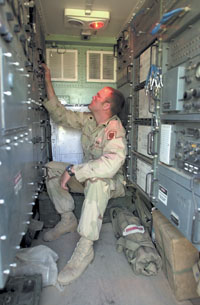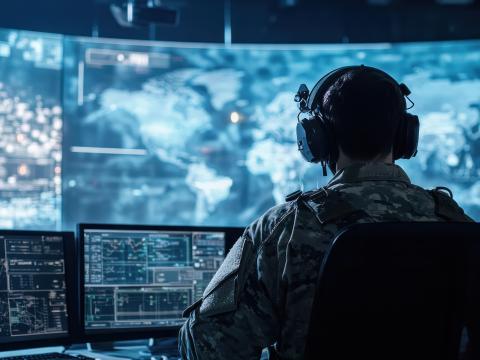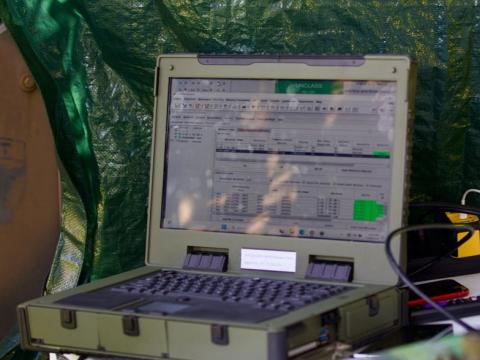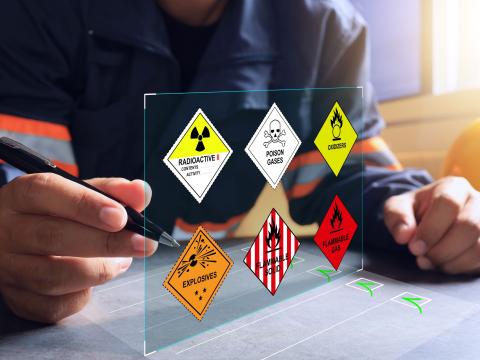Training Transforms
 |
| Members of C Company, 86th Signal Battalion, Fort Huachuca, troubleshoot communications equipment at Camp Virginia in Kuwait. They are (standing l-r) Spc. Jason Wilson, USA; Staff Sgt. Theodore Washington, USA; 1st Lt. Matthew Jeffcoat, USA; (seated l-r) Sgt. Andrew Topham, USA; Spc. David Hamilton, USA; and Staff Sgt. Jeff Fabor, USA. The 86th battalion is a subordinate battalion of the 11th Signal Brigade that was deployed to Kuwait to support communications for units deployed to U.S. Central Command’s area of responsibility. |
The U.S. Army’s force restructuring effort is affecting every aspect of the service, including the way signal soldiers train. To address the communications needs of modular units, the U.S. Army Signal Center, Fort Gordon, Georgia, is helping to create a multifunctional signal soldier who can accomplish different tasks as required by the unit. As joint operations drive doctrine and technical solutions, the Army’s junior leaders are being taught from the start to think about how the Army works with the other services beyond the realm of joint task forces.
Maj. Gen. Janet A. Hicks, USA, commanding general of the Signal Center and Fort Gordon, is leading the charge to change the way signal soldiers are trained to meet the needs of the restructured force. She recognizes the challenges the modular configuration poses to communicators but has confidence in today’s soldiers and their abilities.
In the traditional formation of Army troops, the vast majority of communications equipment and soldiers are consolidated at the battalion level. These are then assigned to maneuver and support units as required and brought back into the signal battalion formation after a mission is complete.
But the service already has started moving to units of action (UAs), a transformational effort that began with the 3rd Infantry Division. The Army will have 43 or possibly 48 UAs. Army leaders also have agreed on the structure of the unit of employment (higher tactical), or UEx, and work continues on the design of a unit of employment (operational land), or UEy.
“Signal equipment and soldiers in the UExs will be assigned directly to the UAs,” Gen. Hicks explains. “UA commanders will ‘own’ their signal equipment and soldiers. This distributed organization has challenges. Collective training for the UEx network enterprise, for example, and network management of the entire enterprise are the two toughest challenges.”
To address these issues, the general says the Army is creating a multifunctional signal soldier. Today, one signaleer may be responsible for installing radio systems while another may act as the switch operator. The new construct may require that a soldier be capable of handling both tasks. “We’re streamlining the number of MOSs [military occupational specialties], validating the skills required by those fewer MOSs and retooling the schoolhouse to accommodate the changes,” Gen. Hicks says.
In the midst of this transformation of training, the general relates that commanders in the field already have begun to restructure and create teams to support warfighting formations with voice, data and video services.
Besides training requirements, the breadth of understanding for lieutenants, captains and noncommissioned officers will increase, she adds. Although signal soldiers always have been able to multitask, this will be “kicked up a notch” as one soldier will be performing more tasks in an MOS as a member of “small, lean, capable” communications support teams. “Our most junior leaders will think joint in the future all the time and not just when deployed in a joint task force. Joint operations will drive our doctrine and material solutions across the board,” Gen. Hicks states.
 |
| Spc. Andrew Gambordella, USA, 514th Signal Company, operates long-range-extension communications near As Samawa, Iraq, which supports the command and control elements of the 82nd Airborne Division involved in operation Iraqi Freedom. The Army’s communicators already are being trained to be able to handle a multitude of tasks while working within UAs. |
In addition to adapting to the requirements of the force restructuring, signaleers must keep up with the changes in technology. Gen. Hicks relates that the Blue Force Tracking system has finally allowed the Army to handle ground force tracking in the same way the U.S. Navy and U.S. Air Force have been able to keep track of their troops for some time.
Other technological advances also have helped the service during current operations. “Battle Command on the Move emerged as a huge winner in Iraq … absolutely essential for communication support of the commander who must be constantly on the move, such as our forces’ drive to Baghdad. Commanders can’t wait for situational awareness while ground rods are being driven in and antennas are being erected. They must have it while they’re hauling down the road, while mobile,” the general notes. Advances in antenna technology helped make this possible, she adds, especially on-the-move satellite tracking.
Gen. Hicks maintains that systems must be built that do not require extra layers, such as interface devices, to make them work. While warfighters have been very resourceful in solving problems on the fly, the general asserts that standards are required at the U.S. Defense Department level that enable all of the services to field equipment that complements other services’ systems. These must be broad, flexible and enforced. “Absent that guidance and those standards, services field what they need and service interoperability isn’t achieved,” she states.
Feedback from warfighters involved in current operations has been extremely helpful to the Army, the general shares. The command is receiving excellent spot reports, after action reports, lessons learned and “plain old e-mail notes” from signal soldiers and others on the ground in operations Enduring Freedom and Iraqi Freedom. “Their feedback and suggestions are insightful, absolutely relevant and exactly what we need to stay realistic as we move to equip and restructure the force of the future,” she says.
Lt. Gen. Anthony R. Jones, USA, deputy commander, U.S. Army Training and Doctrine Command, Fort Monroe, Hampton, Virginia, maintains that the introduction of UAs and other transformational initiatives requires a new approach to training soldiers. Rather than teaching warfighters what to think, the new force structure will require that they learn how to think. Gen. Hicks agrees that, while young soldiers and seasoned noncommissioned officers step up and take charge in the absence of a leader, this is a skill that all soldiers must be taught.
“This is our strength, and we must teach soldiers across the force how to think through tasks, missions and tough problems so that they can accomplish tough missions in the absence of that noncommissioned officer. We will operate in much smaller, task-organized elements—small teams deploying, sometimes without a robust support chain. Soldiers must be able to think on their feet, work through difficulties and prevail. This is what I would describe as ‘how to think’ rather than ‘what to think.’ ‘What to think’ gives you someone who can obey, not take charge,” she states.
Web Resources
Fort Gordon: www.gordon.army.mil
U.S. Army Network Enterprise Technology Command: www.tradoc.army.mil/index.html
9th Army Signal Command: www.asc.army.mil




Comments